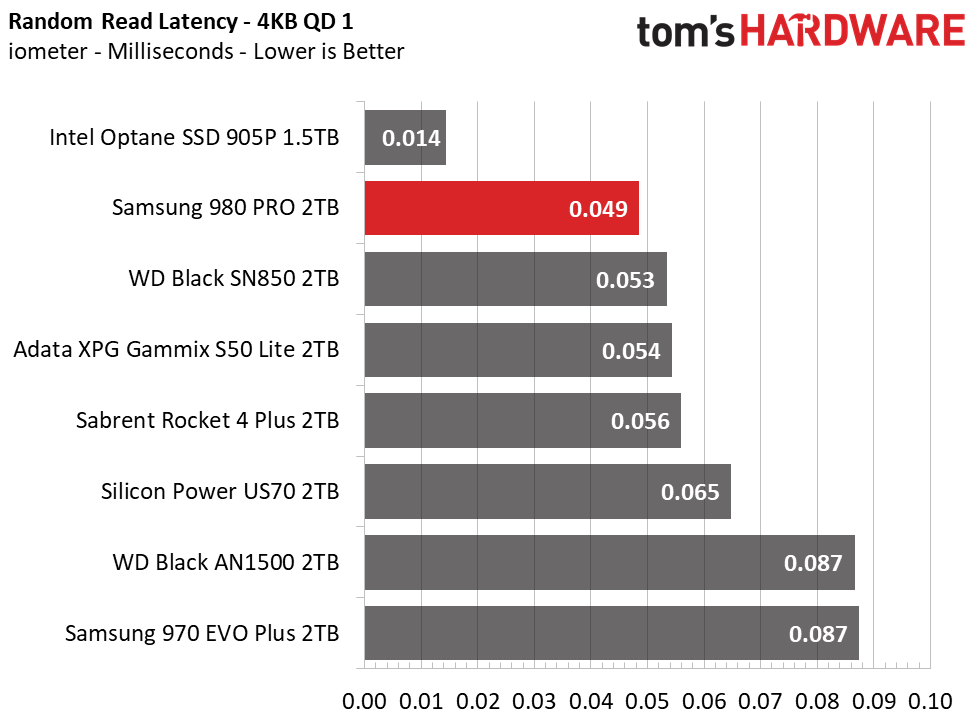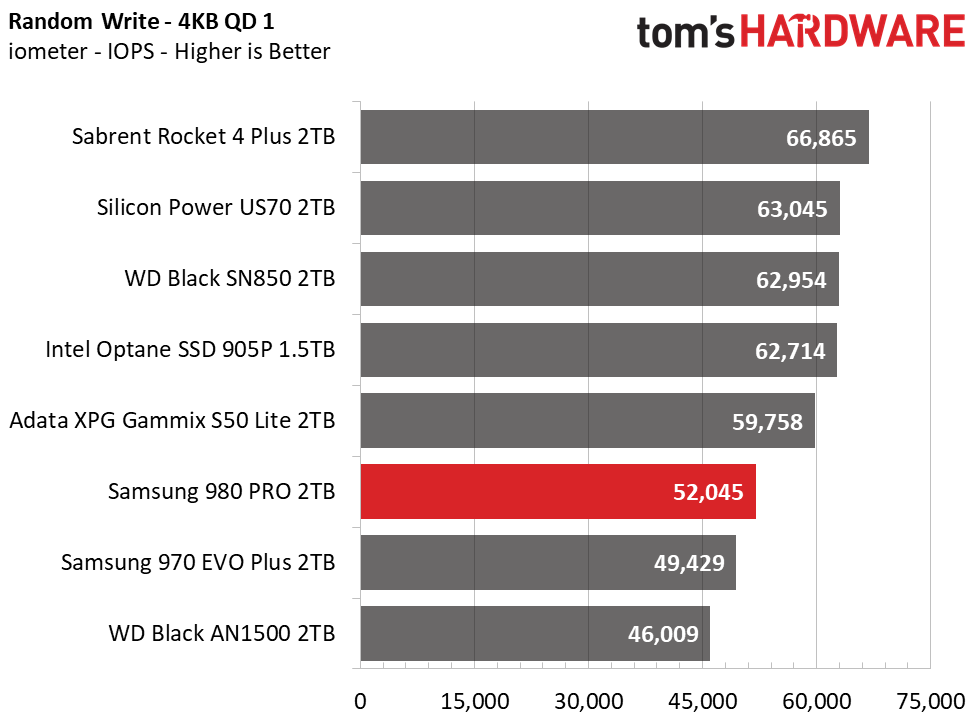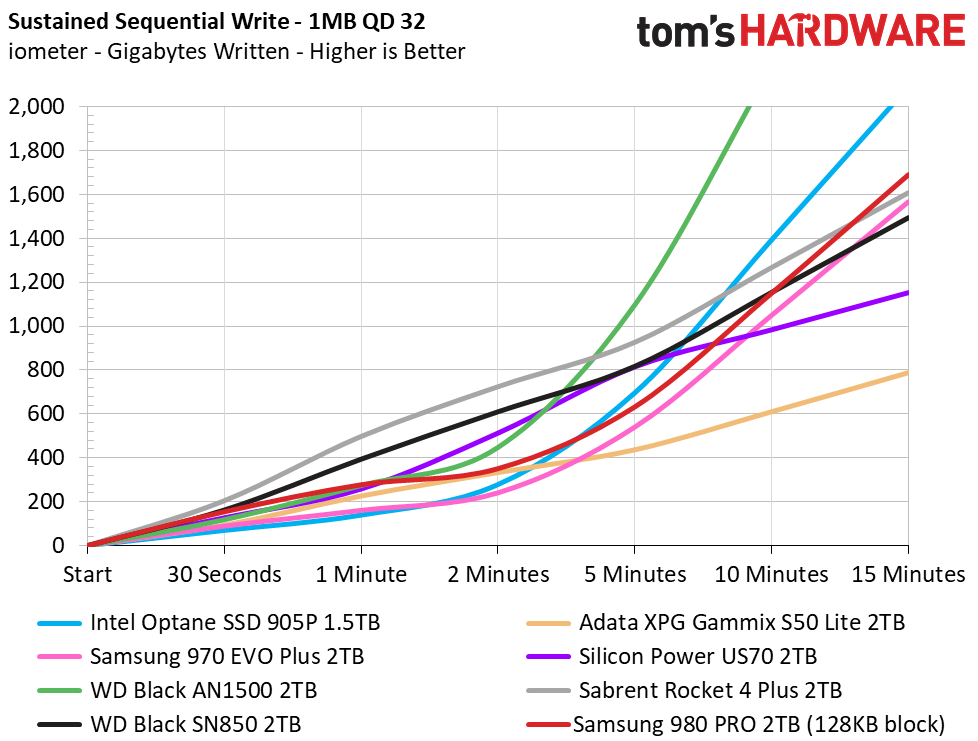Why you can trust Tom's Hardware
Comparison Products
We put the Samsung 980 Pro up against several of the best NVMe SSDs in the market, including Samsung’s biggest competitor, the WD Black SN850, as well as some cheaper alternatives like the Sabrent Rocket 4 Plus, Silicon Power US70, and Adata XPG Gammix S50 Lite. We also threw in the Samsung 970 EVO Plus and the WD Black AN1500, a RAID 0 add-in card (AIC) that comes armed with twin WD Black SN730s. We also threw in the now-discontinued Intel Optane SSD 905P because of its massive advantage in random workloads
Game Scene Loading - Final Fantasy XIV
Final Fantasy XIV Shadowbringers is a free real-world game benchmark that easily and accurately compares game load times without the inaccuracy of using a stopwatch.
Samsung’s 980 Pro delivered very responsive level load times that should carry over to most games, but it wasn’t quite as responsive as the Intel Optane SSD 905P. The Adata XPG Gammix S50 Lite even outperformed the Samsung in this test, and because it is a relatively light pure read workload, the Samsung 970 EVO Plus.
Transfer Rates – DiskBench
We use the DiskBench storage benchmarking tool to test file transfer performance with our own custom blocks of data. Our 50GB data set includes 31,227 files of various types, like pictures, PDFs, and videos. Our 100GB consists of 22,579 files, with 50GB of them being large movies. We copy the data sets to new folders and then follow-up with a reading test of a newly written 6.5GB zip file and 15GB movie file.


When it comes to copying folders of data, Samsung’s 980 Pro delivers performance that is second to none. However, when reading back our large zip file, the Sabrent Rocket 4 Plus and WD Black SN850 demonstrated faster performance, though only by 60-80 MBps.
Trace Testing – PCMark 10 Storage Tests
PCMark 10 is a trace-based benchmark that uses a wide-ranging set of real-world traces from popular applications and everyday tasks to measure the performance of storage devices. The quick benchmark is more relatable to those who use their PCs for leisure or basic office work, while the full benchmark relates more to power users.






For those looking for the most responsive performance in applications, the WD Black SN850 edges ahead of the Samsung 980 Pro in the PCMark 10 storage workloads. Samsung’s 980 Pro ranks in third place in both the Quick and Full System Drive Benchmarks, lagging both the WD and Intel Optane SSD 905P. While Sabrent’s Rocket 4 Plus comes close here, its weaker random read performance holds it back from overthrowing either the WD or Samsung drives.
Get Tom's Hardware's best news and in-depth reviews, straight to your inbox.
Synthetic Testing - ATTO / iometer
iometer is an advanced and highly configurable storage benchmarking tool, while ATTO is a simple and free application that SSD vendors commonly use to assign sequential performance specifications to their products. Both of these tools give us insight into how the device handles different file sizes.










We tested Samsung’s 980 Pro at a QD of 1, representing most day to day file access at various block sizes, and while it was rather responsive with smaller files, it seems to suffer from a dip in performance as it scales up to larger block sizes. The drive’s read performance suffered with large 1MB blocks, and this tendency carried over into our other synthetic testing.
Peak read performance measured just 6.8 GBps with 1MB blocks but easily surpassed 7.1 GBps with 128KB blocks. The Samsung 980 Pro’s write performance shows less-than-optimal results with a 1MB block size, too, peaking at 4.5 GBps write. However, it sustained speeds of over 5.2 GBps with 128KB blocks, exceeding its official rating.
Additionally, the Samsung 980 Pro’s random read performance was the most impressive we’ve seen with a flash-based SSD, but its write performance could bear some improvement. Samsung’s Rocket 4 Plus displays some of the lowest-latency response in random write workloads, although the WD Black SN850 offers up both fast random read and write speeds across the board.
Sustained Write Performance and Cache Recovery
Official write specifications are only part of the performance picture. Most SSDs implement a write cache, a fast area of (usually) pseudo-SLC programmed flash that absorbs incoming data. Sustained write speeds can suffer tremendously once the workload spills outside of the cache and into the "native" TLC or QLC flash. We use iometer to hammer the SSD with sequential writes for 15 minutes to measure both the size of the write cache and performance after the cache is saturated. We also monitor cache recovery via multiple idle rounds.





We usually test the SLC cache, or in this case, TurboWrite, by writing to the SSD with a 1MB block size. However, because of the performance scaling issues present in our synthetic testing, we adjusted our settings to a 128KB block size here. At 2TB, the Samsung 980 Pro’s cache measured 238GB, writing at a speed of roughly 5.1GBps until full. After the TurboWrtite cache filled, write speeds degraded to approximately 1.5 GBps, but then ramped up to 2GBps, averaging 1.7 GBps until the device filled.
While it doesn’t have a massive SLC cache like the Sabrent or WD drives, the Samsung 980 Pro’s worst-case write performance was very good. But, when it came to cache recovery, the Samsung SSD recovered only its static SLC cache within our 30-min idle window. In contrast, drives like the WD Black SN850 and Sabrent Rocket 4 Plus consistently recovered tens to hundreds of gigabytes of their cache.
Power Consumption and Temperature
We use the Quarch HD Programmable Power Module to gain a deeper understanding of power characteristics. Idle power consumption is an important aspect to consider, especially if you're looking for a laptop upgrade. Some SSDs can consume watts of power at idle, while better-suited ones sip just milliwatts. Average workload power consumption and max consumption are two other aspects of power consumption, but performance-per-watt is more important. A drive might consume more power during any given workload, but accomplishing a task faster allows the drive to drop into an idle state faster, ultimately saving power.
We also monitor the drive’s temperature via the S.M.A.R.T. data and an IR thermometer to see when (or if) thermal throttling kicks in and how it impacts performance. Bear in mind that results will vary based on the workload and ambient air temperature.




Samsung’s new 8nm NVMe controller and 128L V-NAND TLC flash make for a very efficient pair. The 980 Pro consumes less power than everything but the Adata XPG Gammix S50 Lite. It also has the fastest performance during the 50GB copy test, helping it take first place on our efficiency chart. It also sips less power than its competition when idle, helping keep the drive cool.
You shouldn’t need added cooling under most workloads, even at the 2TB capacity, but extra cooling is recommended for power users. After sustaining roughly 500GB worth of writes, the 980 PRO did not display any signs of thermal throttling in a 24C room on an open-air test bench with no forced airflow. The 980 Pro’s S.M.A.R.T. data reported a peak temperature of 69 degrees Celsius on sensor one and 88 degrees Celsius on sensor two. The surface of the controller measured 76 degrees Celsius with the IR thermometer.
MORE: Best SSDs
MORE: How We Test HDDs And SSDs
MORE: All SSD Content

Sean is a Contributing Editor at Tom’s Hardware US, covering storage hardware.
-
dmitche31958 I would have liked to see how this compares to the Corsair MP600. No need to compare these to SATA SSDs but other PCI 4.0 are. While it's nice to see comparisons of this type they can lead one to believe that the items are better than they truly are.Reply -
derekullo What's the point of a Pro model with turbowrite?Reply
I guess every company has a "Netburst" -
seanwebster Reply
The Team Group Cardea Ceramic C440 and Corsair Force MP600 are the same hardware and near-identical firmware save for AES 256-bit encryption being unlocked on the MP600. You can basically just swap names since the performance figures are comparable. I wish I had a 500GB E16-based SSD to compare, but for now, the 1TB and up is all I got with that controller.dmitche31958 said:I would have liked to see how this compares to the Corsair MP600. No need to compare these to SATA SSDs but other PCI 4.0 are. While it's nice to see comparisons of this type they can lead one to believe that the items are better than they truly are. -
Rob1C After reading Tom's article: "Sabrent Crushes Samsung At Their Own Game: Builds World's Fastest M.2 SSD" I'd like to have seen it included in the charts in this article (save for a very brief mention).Reply -
Rognis I'm surprised the Sabrent pcie 4.0 TLC drive wasn't in the compared list, unless it's just so bad there wasn't a reason to add it?Reply -
Friesiansam 980 Pro is certainly quick but, by the time my 970 Pro goes belly-up, there'll be something quicker and cheaper with more durability.Reply -
mattkiss Why is the WD SN550 random read 4K QD1 iops so much lower than it's outstanding random write 4K QD1 iops? Just curious b/c I'm interested in the 1 TB version of the SN550.Reply -
0112358 No mention in the article, but current, other 7,000+ MB/s read-speed SSDs include:Reply
1) Gigabyte's AORUS Gen4 AIC 2 TB & 8 TB RAID card, with read speeds of up to 15,000 MB/s (via Phison’s 3D TLC PS5016-E16 controller), and
2) ADATA's XPG GAMMIX S70 PCIe 4.0 SSD -- up to 7,500 MB/s.
"Just sayin'..." -
0112358 Reply
The Samsung 980 is nearly 50% faster than Sabrent's best for read-speed...so there's that.Rognis said:I'm surprised the Sabrent pcie 4.0 TLC drive wasn't in the compared list, unless it's just so bad there wasn't a reason to add it? -
salgado18 Reply
Considering my 840 EVO is still going strong as a system and programs drive, you will probably upgrade to a PCIe 6.0 drive :sweatsmile:Friesiansam said:980 Pro is certainly quick but, by the time my 970 Pro goes belly-up, there'll be something quicker and cheaper with more durability.

